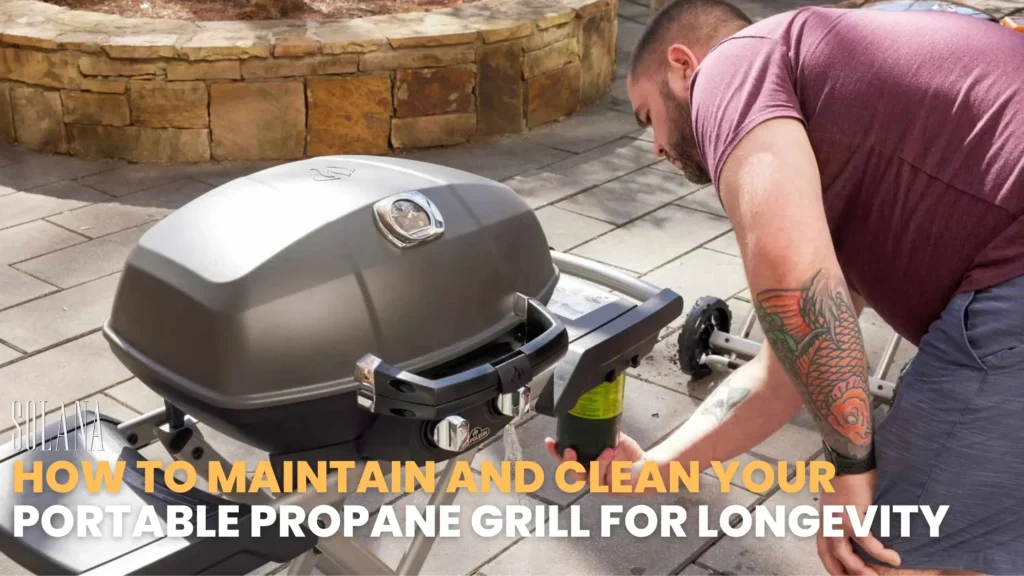
Keeping your portable propane grill in top condition is essential for ensuring it performs at its best, lasts longer, and provides safe and delicious meals every time you use it. Proper propane grill maintenance involves regular cleaning, inspections, and using the right accessories to make the process easier and more effective. In this comprehensive guide, we will dive into the importance of propane grill maintenance, provide a step-by-step guide on how to clean a propane grill, and share tips for regular grill upkeep and extending its lifespan. Whether you’re a seasoned griller or a novice, these practical tips will help you maintain your portable propane grill and enhance your grilling experience. Understanding the Importance of Propane Grill Maintenance Propane grill maintenance is crucial for several reasons, ranging from safety and performance to extending the lifespan of your grill. Here’s why maintaining your propane grill should be a priority: Safety Regular propane grill maintenance is essential for ensuring safety. A dirty or poorly maintained grill can pose serious risks, including grease fires, gas leaks, and flare-ups. Regular cleaning and inspections help identify and address potential hazards, ensuring a safe grilling environment. Performance A properly maintained grill ensures optimal performance, delivering even heat and reliable cooking results every time. Grease and food residue can clog burners and affect flame patterns, leading to uneven cooking. Proper propane grill maintenance ensures your grill delivers optimal performance every time you use it. Flavor Over time, built-up grease and residue can impart unwanted flavors to your food. Regular cleaning removes these residues, ensuring your grilled meals taste fresh and delicious. Longevity Investing in a propane grill isn’t cheap, so it’s essential to take care of it. Regular maintenance helps prevent rust, corrosion, and wear, extending the lifespan of your grill. By keeping it in good condition, you’ll enjoy many years of reliable service from your propane grill. Convenience Knowing how to clean a propane grill and perform basic maintenance tasks makes the overall grilling experience more enjoyable and efficient. With the right grill tools and tips, grill upkeep becomes a hassle-free part of your routine. How to Clean a Propane Grill: Step-by-Step Guide Step 1: Gather Your Cleaning Supplies Before you start, gather the necessary cleaning supplies: Grill brush with stiff bristles Scraper or putty knife Warm soapy water Sponge or cloth Bucket Paper towels Stainless steel cleaner (if applicable) Step 2: Pre-Clean the Grill For proper propane grill maintenance, start by pre-cleaning the grill: Shut off the propane supply and safely detach the tank from the grill. Remove the grill grates, heat deflectors, and burner covers. Scrape off any large food particles and grease from the grates and internal components using a scraper or putty knife. Step 3: Clean the Grill Grates Knowing how to clean a propane grill means paying attention to the grill grates: Soak the grill grates in warm soapy water for about 15-20 minutes. Use a grill brush to scrub away any stubborn residue on the grates. Thoroughly rinse with clean water and let the air dry completely. Step 4: Clean the Interior Cleaning the interior is crucial for propane grill maintenance: Remove any debris from the bottom of the grill using a scraper. Scrub the interior surfaces with a sponge or cloth soaked in warm soapy water. Rinse the interior with clean water and wipe it dry with paper towels. Step 5: Clean the Burners Regular burner maintenance is essential for grill upkeep: Check the burners for any clogs or blockages. Gently brush the burner ports to clear away any debris and ensure proper gas flow. Ensure the burners are aligned correctly when reassembling the grill. Step 6: Clean the Exterior Maintaining the exterior is part of overall propane grill maintenance: Clean the exterior surfaces using a damp cloth to remove dirt and grease. Use a stainless steel cleaner if your grill has stainless steel components. Dry the exterior thoroughly to prevent water spots and rust. Step 7: Reassemble the Grill After ensuring all parts are thoroughly cleaned and dried, put the grill back together. Reconnect the propane tank and test the grill to ensure it’s functioning correctly. Essential Accessories for Effective Grill Maintenance Having the right tools and accessories makes propane grill maintenance more manageable and effective. Here are some essential accessories to consider: Grill Brush A good grill brush is essential for cleaning your grill grates and removing stubborn residue. Choose a brush with stiff bristles and a long handle for better leverage and safety. Scraper A scraper or putty knife helps remove large food particles and grease from grates and interior surfaces. It’s a handy tool for initial cleaning before using soapy water. Grate Cleaner Specialized grate cleaners are designed to dissolve grease and grime from grill grates. They can make the cleaning process more efficient and thorough. Degreaser A degreaser is useful for breaking down tough grease and residue on grill surfaces. It’s especially helpful for cleaning the interior and burners. Stainless Steel Cleaner For grills with stainless steel components, a stainless steel cleaner helps maintain their appearance and prevent corrosion. Drip Pan Liners Disposable drip pan liners make cleanup easier by catching grease and drippings. They also help prevent flare-ups and keep the grill’s interior cleaner. Heat-Resistant Gloves Heat-resistant gloves protect your hands while handling hot grill components during cleaning and maintenance. Using these grill accessories can significantly improve your propane grill maintenance routine, making it more efficient and effective. Tips for Regular Grill Upkeep Regular maintenance is key to keeping your propane grill in excellent condition. Here are some tips for ongoing grill upkeep: Before Each Use Inspect for Leaks: Check the propane tank connections and hoses for leaks before lighting your grill. A simple soapy water solution applied to the connections can help detect any leaks (bubbles will form if there’s a leak). Clean Grates: Give the grates a quick brush to remove any food residue from the previous use. Check Burner Flames: Ensure the flames are blue and even. Yellow flames
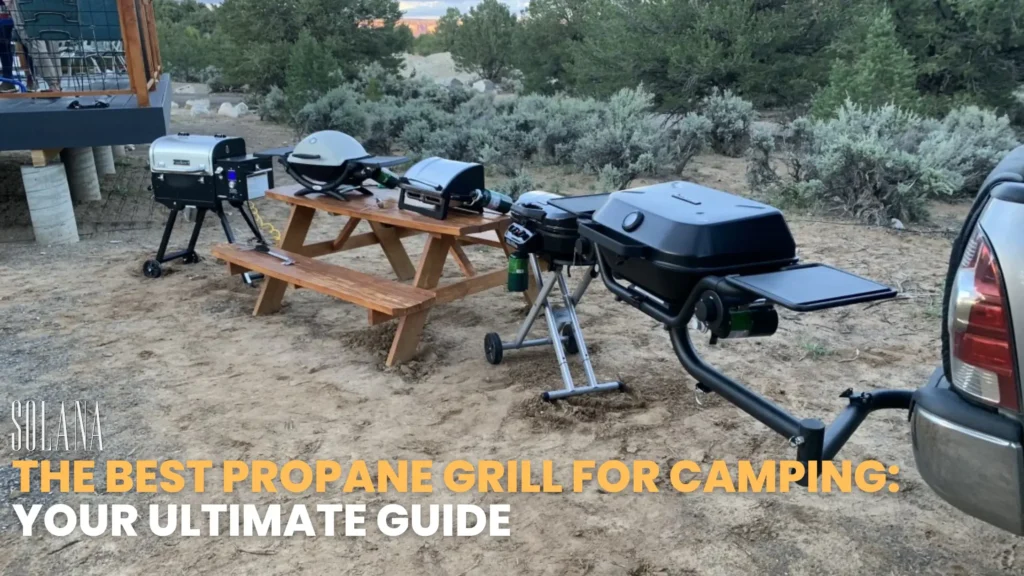
When planning a camping trip, one of the essential items to include is a grill, ensuring you can enjoy delicious meals in the great outdoors. The best propane grill for camping offers the perfect combination of convenience, portability, and performance, making it a must-have for outdoor enthusiasts. In this comprehensive guide, we’ll explore why a propane grill is perfect for camping, key features to consider, top recommendations, and the importance of having the right accessories to enhance your grilling experience. If you’re a seasoned camper or new to outdoor adventures, this guide will help you choose the best propane grill for your needs. Why a Propane Grill is Perfect for Camping The best propane grill for camping is an invaluable tool for several reasons, making it the preferred choice for campers and outdoor enthusiasts. Here are some key reasons why a propane grill is ideal for your next camping trip: Convenience and Ease of Use One of the primary benefits of a propane grill is its convenience. These grills are designed for easy operation, offering instant ignition and rapid heat-up times. The best propane grill for camping allows you to start cooking within minutes, eliminating the need for lengthy prep work and providing quick meals on the go. Consistent Temperature Control Propane grills offer precise temperature control, which is crucial for achieving consistent cooking results in the great outdoors. The ability to adjust the flame with a simple turn of a knob ensures that your food is cooked evenly and to your liking. This level of control is especially useful when camping, where you might be dealing with variable weather conditions. Portability The best propane grill for camping is designed with portability in mind. These grills are typically lightweight, compact, and easy to transport, making them perfect for packing in your vehicle or carrying to your campsite. Features like foldable legs and carrying handles further enhance their portability, ensuring you can set up and cook wherever you are. Clean Burning Fuel Propane is a clean-burning fuel, producing fewer pollutants and less smoke compared to charcoal. This makes it an environmentally friendly option for outdoor cooking. Additionally, propane grills are easier to clean, as there is no ash or residue left behind after cooking. Versatility Propane grills are versatile enough to handle a wide range of foods, from burgers and hot dogs to vegetables and seafood. The best propane grill for camping often comes with additional features like griddles and side burners, allowing you to expand your cooking options and prepare a variety of meals. Key Features to Look for in the Best Propane Grill for Camping When selecting the best propane grill for camping, it’s important to consider several key features that will enhance your cooking experience and ensure you get the most out of your grill. Here are the critical factors to keep in mind: Cooking Area The size of the cooking area is a crucial consideration. The best propane grill for camping should provide enough space to cook meals for your group without being overly bulky. A grill with a cooking area of around 200-300 square inches is typically sufficient for most camping needs. BTU Rating BTU (British Thermal Units) measures the heat output of the grill. A higher BTU rating generally indicates a more powerful grill, but it’s important to balance this with the cooking area to ensure efficiency and even cooking. The best propane grill for camping should have a BTU rating that provides adequate heat without consuming excessive fuel. Build Quality and Materials Durability is essential for a camping grill that will be exposed to the elements. Look for grills constructed from high-quality materials like stainless steel or cast aluminum, which resist rust and corrosion. The best propane grill for camping should be built to withstand outdoor conditions and frequent transport. Portability Features Key portability features include a lightweight design, foldable legs, and carrying handles. These features make the best propane grill for camping easy to transport and set up, ensuring you can enjoy grilled meals wherever your adventures take you. Ignition System A reliable ignition system is a must for any propane grill. The best propane grill for camping should have a push-button or electronic ignition system that provides quick and dependable lighting, reducing the hassle of starting your grill in outdoor conditions. Additional Features Some propane grills come with bonus features like side tables, temperature gauges, and griddle attachments. While not essential, these extras can enhance your grilling experience, providing added convenience and versatility when cooking outdoors. Price and Warranty Take into account your budget and the manufacturer’s warranty to ensure long-term value and protection for your investment. The best propane grill for camping should offer good value for money, balancing quality and features with cost. A reliable warranty ensures confidence in your purchase while safeguarding your investment. Top Picks: Best Propane Grills for Camping To help you find the best propane grill for camping, we’ve compiled a list of top recommendations based on performance, portability, and user reviews. Here are some of the best options available: Weber Q1200 The Weber Q1200 is a top-rated choice for campers, offering a compact design with 189 square inches of cooking space and a 12,000 BTU burner. Made from durable cast aluminum, it features a reliable electronic ignition system and porcelain-enameled cast-iron cooking grates. The Weber Q1200 is lightweight, easy to transport, and provides consistent cooking results, making it one of the best propane grills for camping. Coleman RoadTrip LXE The Coleman RoadTrip LXE is known for its impressive portability and versatile cooking options. This grill boasts 285 square inches of cooking space and 20,000 BTUs of heat, with two independently adjustable burners. The collapsible stand and easy-roll wheels make it a breeze to transport. The swap-top interchangeable cooktops allow you to switch between grilling and griddling, making it perfect for various outdoor cooking needs. Camp Chef Portable BBQ Grill The Camp Chef Portable BBQ Grill is a versatile and reliable option for campers. Offering
The debate between propane vs. charcoal grill enthusiasts is ongoing and heated, much like the grills themselves. This comprehensive guide aims to help you decide which grill type best suits your needs, by examining the nuances of propane and charcoal grills and highlighting the importance of having the right accessories to enhance the grilling experience. If you’re a casual weekend griller or a seasoned barbecue aficionado, understanding the pros and cons of each grill type is essential for making an informed choice. We’ll delve into their advantages, drawbacks, safety measures, and the role of essential grilling accessories in maximizing your outdoor cooking experience. Propane vs. Charcoal Grill: An Overview The choice between a propane vs. charcoal grill often boils down to personal preference and grilling style. Here’s a brief overview of both grill types: Propane Grills Propane grills, also known as gas grills, operate using propane gas as the fuel source. These grills are renowned for their convenience and ease of use. With a simple press of a button, they ignite instantly and offer precise temperature control. Popular among those who value efficiency and consistency, propane grills are designed for quick and convenient grilling. Charcoal Grills Charcoal grills, on the other hand, use charcoal briquettes or lump charcoal as fuel. These grills are celebrated for the authentic smoky flavor they impart to food. Cooking on a charcoal grill is more of an art form, requiring time and effort to achieve the right heat and flavor. Charcoal grills are favored by traditionalists who relish the hands-on approach to grilling. Advantages of Propane Grills Propane grills come with several distinct advantages that make them a popular choice for many outdoor cooking enthusiasts. Here are the key benefits: Instant Ignition and Heat One of the most significant advantages of propane grills is their instant ignition and rapid heat-up time. With a simple push-button or electronic ignition system, propane grills are ready to use within minutes, allowing you to start cooking almost instantly. This quick setup is ideal for busy individuals who want a speedy grilling experience. Precise Temperature Control Propane grills offer precise temperature control through adjustable knobs, allowing you to regulate the heat accurately. This control is crucial for achieving consistent cooking results and preventing food from burning. The ability to adjust the flame with ease makes propane grills user-friendly and versatile. Convenience and Ease of Use Propane grills are incredibly convenient to use. They require minimal prep time, and the propane canisters are easy to connect and replace. The simplicity of operation appeals to both novice and experienced grillers, making outdoor cooking a hassle-free experience. Cleaner Burning Fuel Propane is a cleaner-burning fuel compared to charcoal, producing fewer pollutants and less smoke. This environmentally friendly aspect is important for those concerned about air quality and reducing their carbon footprint. Versatility Modern propane grills often come with additional features like side burners, rotisserie attachments, and smoking boxes, enhancing their versatility. These built-in components expand your cooking options, allowing you to prepare a wider variety of dishes beyond traditional grilling. Advantages of Charcoal Grills While propane grills offer convenience, charcoal grills have their own set of advantages that appeal to purists and barbecue enthusiasts alike. Here’s why charcoal grills are favored: Authentic Smoky Flavor The most celebrated advantage of charcoal grills is the rich, smoky flavor they impart to food. The combustion of charcoal produces unique flavors that penetrate the meat, creating the quintessential barbecue taste that propane grills struggle to replicate. Higher Temperature Range Charcoal grills can achieve higher temperatures than propane grills, making them ideal for searing meats and creating a desirable crust on steaks and burgers. The ability to reach and sustain high temperatures is crucial for certain grilling techniques. Traditional Grilling Experience Grilling on a charcoal grill is a more hands-on, traditional experience that many find enjoyable and rewarding. The process of lighting the charcoal, adjusting the airflow, and managing the coals to achieve the perfect cooking conditions is part of the charm and appeal. Cost-Effective Charcoal grills generally come at a lower price point compared to propane grills. The initial purchase cost and ongoing fuel expenses are lower, which can be a significant advantage for budget-conscious consumers. Portability Charcoal grills are generally more portable than propane grills, especially smaller models designed for camping and tailgating. They are lightweight and don’t require a propane canister, making them easy to transport. Key Factors to Consider When Choosing a Grill Selecting the right grill involves considering several key factors that align with your grilling needs and preferences. Here’s what to keep in mind: Cooking Style Your preferred cooking style will greatly influence your choice between a propane vs. charcoal grill. If you favor convenience and quick grilling, a propane grill is ideal. For those who love the traditional smoky flavor and don’t mind a hands-on approach, a charcoal grill is the better option. Frequency of Use Assess how often you plan to use your grill. Propane grills are better suited for frequent use due to their quick setup and ease of operation. Charcoal grills may be more appropriate for occasional grilling when you have time to enjoy the process. Available Space Consider the space available for your grill. Propane grills often require more room due to their larger size and propane tanks. Charcoal grills, especially smaller models, are more compact and easier to fit into limited spaces. Budget Budget is a crucial factor. Propane grills tend to be more expensive initially, while charcoal grills are usually more budget-friendly. Factor in ongoing fuel costs as well – propane is more costly than charcoal over time. Flavor Preference If achieving a rich, smoky flavor is your primary goal, a charcoal grill is the way to go. Propane grills can produce delicious food but may not provide the same depth of flavor as charcoal. Portability For those who enjoy grilling on the go, portability is essential. While both propane and charcoal grills can be portable, charcoal grills offer lighter and simpler models. Portable
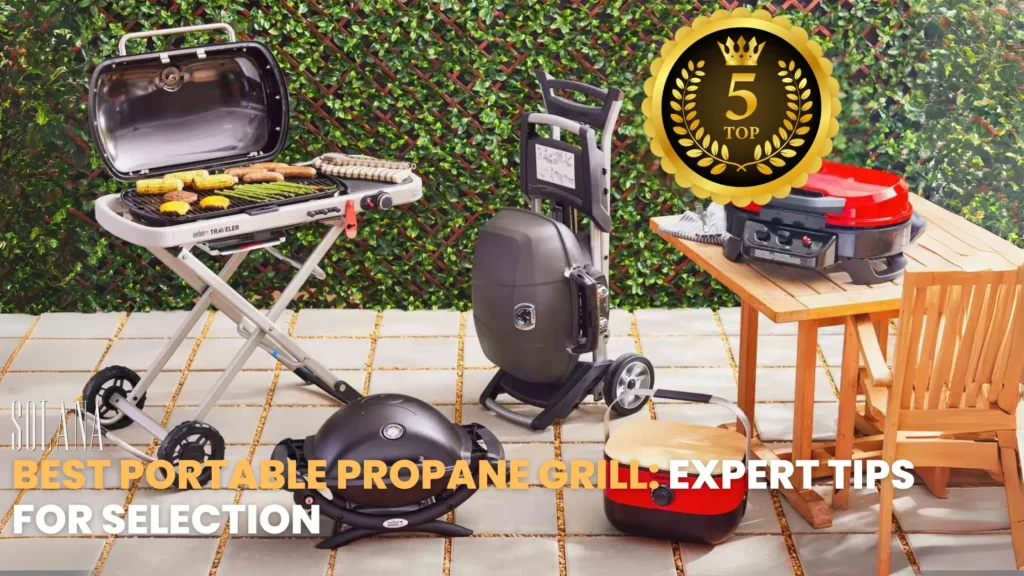
When it comes to outdoor cooking, a portable propane grill is often the go-to choice for its convenience, efficiency, and ease of use. If you’re planning a camping trip, tailgating, or simply enjoying a backyard barbecue, a portable propane grill offers unparalleled flexibility and performance. This comprehensive guide will walk you through everything you need to know about selecting the best portable propane grill. We’ll cover important considerations such as key features, portability, and overall performance. By the end of this guide, you’ll be well-equipped to make an informed decision and take your grilling game to the next level. Why Choose a Portable Propane Grill? Portable propane grills have become increasingly popular among outdoor cooking enthusiasts, and for good reason. Here are some compelling reasons why you should consider investing in a portable propane grill: Convenience and Ease of Use One of the standout features of a portable propane grill is its ease of use. Propane grills ignite quickly and effortlessly, allowing you to start cooking within minutes. Unlike charcoal grills, which require time and effort to get the coals hot, a portable propane grill can reach the desired cooking temperature almost instantly. Consistent Temperature Control Portable propane grills offer precise temperature control, which is essential for achieving perfect grilling results. The ability to adjust the flame with a simple turn of a knob gives you control over the cooking process, ensuring your food is cooked evenly and to your liking. Portability Designed with mobility in mind, portable propane grills are lightweight and often come with features like foldable legs and carrying handles. This makes them easy to transport and set up, whether you’re at the beach, a campsite, or a tailgate party. Fuel Efficiency Propane is an efficient fuel source that burns cleanly and provides a consistent flame. Portable propane grills are designed to maximize fuel efficiency, allowing you to enjoy extended grilling sessions without frequent refueling. Versatility From burgers and hot dogs to vegetables and seafood, a portable propane grill can handle a variety of foods. Many models come with additional features like side burners and griddles, adding to their versatility. Key Features to Look for in a Portable Propane Grill When shopping for the best portable propane grill, it’s important to consider certain key features that will enhance your grilling experience. Here are some critical factors to take into account: Cooking Area The size of the cooking area determines how much food you can grill at once. If you often cook for groups, a larger cooking area will be beneficial. However, if you usually grill for a small family, a compact grill with a smaller cooking surface may suffice. BTU Rating BTU (British Thermal Units) indicates the amount of heat a grill can produce. While a higher BTU rating generally indicates a more powerful grill, it’s crucial to balance BTUs with the grill’s cooking area for optimal performance. A grill with high BTUs but poor heat distribution can lead to uneven cooking. Build Quality and Materials Durability is essential for any grill, especially a portable one that may be exposed to the elements. Look for grills constructed from high-quality materials like stainless steel, which resists rust and corrosion. The build quality of the grill’s grates, burners, and body will impact its longevity and performance. Portability Features Key portability features include foldable legs, carrying handles, and locking lids. These features make transporting and storing the grill much easier. Consider the weight of the grill as well, as you’ll want something light enough to carry but sturdy enough to handle regular use. Ignition System A reliable ignition system is a must for any propane grill. Look for models with a push-button or electronic ignition system, which offers quick and dependable lighting. Additional Features Some portable propane grills come with bonus features like side tables, temperature gauges, and built-in thermometers. While not essential, these extras can enhance your grilling experience and offer added convenience. Price and Warranty Lastly, take into account your budget and the manufacturer’s warranty for added value and peace of mind. A higher-priced grill typically offers better quality and features, but it’s essential to find a balance that fits your needs and budget. A good warranty will provide peace of mind and protect your investment. Looking for specific recommendations? Check out our top 5 portable propane grills for camping and tailgating in 2025. Best Portable Propane Grills of 2025 To help you make an informed decision, we’ve compiled a list of the best portable propane grills for 2025. These models provide exceptional performance, durability, and convenience: Weber Q1200 The Weber Q1200 is a top choice for many outdoor cooking enthusiasts. With a cooking area of 189 square inches and a 12,000 BTU burner, it offers excellent heat distribution for even cooking. The Q1200 is built from cast aluminum, making it durable and lightweight. It features a reliable electronic ignition system and porcelain-enameled cast-iron cooking grates. Coleman RoadTrip LXE The Coleman RoadTrip LXE is renowned for its impressive portability and versatile cooking options. This grill offers 285 square inches of cooking space and 20,000 BTUs of heat. It comes with two independently adjustable burners, a collapsible stand, and easy-roll wheels. The swap-top interchangeable cooktops allow you to switch between grilling and griddling, making it perfect for various outdoor cooking needs. Napoleon TravelQ PRO285X The Napoleon TravelQ PRO285X is a high-performance portable propane grill with 12,000 BTUs and a 285 square inch cooking area. Its unique design includes dual stainless steel burners for superior heat control and even cooking. The PRO285X features a built-in temperature gauge, foldable scissor cart, and side tables, making it exceptionally convenient for travel and storage. Cuisinart CGG-180T Petit Gourmet The Cuisinart CGG-180T Petit Gourmet is a compact and lightweight portable propane grill ideal for small gatherings and picnics. With 5,500 BTUs and 145 square inches of cooking space, it offers efficient grilling in a small package. The Petit Gourmet features a briefcase-style carrying handle, foldable legs, and porcelain-enameled grates for easy transport and

Maintaining your Blaze Grill is crucial to ensure top performance, safety, and longevity. Without proper maintenance, your grill’s performance can decline, and it may even become a safety hazard. Regular Blaze Grill maintenance is essential for every grill owner to understand and practice. By following best practices, you can keep your grill in peak condition for years of delicious outdoor cooking. Essential Blaze Grill Accessories for Improved Grilling To elevate your grilling experience, having the right grill accessories is paramount. These accessories not only enhance your grilling performance but also contribute to safety and convenience. Here are some must-have accessories for your Blaze Grill: Grill Covers: A high-quality grill cover protects your Blaze Grill from external elements like rain, dust, and UV rays. This is vital in preventing rust and wear, extending the lifespan of your grill. Grill Utensils: Invest in sturdy stainless steel utensils like tongs, spatulas, and grill brushes to manage food effectively while grilling. Thermometers: Ensure your meat is cooked to perfection with an accurate thermometer. This avoids undercooking or overcooking and enhances food safety. Grill Mats and Trays: These accessories keep smaller food items from falling through the grates and make the clean-up process easier. Drip Pans: Drip pans collect grease and food drippings, making cleaning more manageable and preventing flare-ups. Grill Lights: If you enjoy nighttime grilling, LED grill lights ensure you have proper visibility when cooking after dark. Including these accessories can significantly enhance your grilling experience and ensure you enjoy a safe, convenient, and enjoyable time grilling. Safety Tips and Tools for Blaze Grill Maintenance Maintaining your Blaze Grill safely is of utmost importance. Using proper tools and following necessary safety measures can prevent accidents and extend the life of your grill. Here are some essential safety tips and tools for Blaze Grill maintenance: Heat-Resistant Gloves: Protect your hands from burns by using heat-resistant gloves when handling hot surfaces or coals. Grill Brushes: Use a grill brush specifically designed for cleaning Blaze Grills. This helps in removing food debris and grease, reducing the risk of flare-ups. Fire Extinguisher: Always keep a fire extinguisher nearby when grilling. It’s a crucial safety tool in case of unexpected fires. Proper Ventilation: Ensure your grilling area is well-ventilated to prevent the buildup of harmful smoke and gases. Gas Line Checks: If using a gas grill, routinely check the propane hose for leaks. Use soapy water and look for bubbles forming when the gas is turned on. Avoid Grease Build-Up: Excess grease can lead to grease fires. Regularly clean the grease traps and ensure the burners are free of excess grease. By incorporating these safety measures and tools, you improve safety and ensure a smooth grilling process. Tips for Convenient Blaze Grill Maintenance Maintaining your Blaze Grill should not be a cumbersome task. With the right tools and practices, you can make grill maintenance simple and hassle-free. Here are some tips: Regular Cleaning Schedule: Establish a routine cleaning schedule for your grill. This will make the process easier and prevent grease buildup. Grill Parts Accessibility: Ensure that the grill parts are easily accessible for cleaning and maintenance. This includes removable grates, burners, and drip trays. Use Easy-to-Clean Materials: Opt for stainless steel grill accessories, as they are durable and easy to clean. Season Your Grill: Just like cast iron, stainless steel grates benefit from seasoning with oil to create a non-stick surface. Keep Replacement Parts Handy: Always have extra burners, ignition systems, and grease trays available to avoid downtime when grilling. With these convenient tips, maintaining your Blaze Grill becomes less of a chore and more of a simple routine. Cleaning and Upkeeping Blaze Grills To ensure your Blaze Grill remains in top condition, regular cleaning and upkeep are essential. Here are some detailed cleaning procedures: Preheat for Easy Cleaning: Preheat your grill for about 15-20 minutes before cleaning. This loosens up food residues and makes them easier to remove. Use the Right Brush: Use a brass or stainless steel grill brush to scrub the grates. Avoid using wire brushes that can leave bristles behind, which may contaminate food. Deep Cleaning: At least once a season, perform a deep cleaning of your Blaze Grill by dismantling and cleaning internal parts thoroughly. Burner Maintenance: Clean the burner tubes regularly to prevent blockages and ensure even heating. Drip Tray Care: Remove and clean drip trays frequently to avoid grease fires. Regular cleaning of Blaze Grills not only enhances performance but also prolongs their lifespan. How to Manage Grease and Prevent Rust Grease and rust are two main enemies of any grill. Proper grease management and rust prevention techniques are crucial for maintaining Blaze Grills: Grease Traps: Use grease traps to collect excess grease. Empty and clean them regularly to prevent grease build-ups. Apply Cooking Oil: After cleaning, apply a thin layer of cooking oil on the grates to prevent rust and keep the grill non-stick. Store in a Dry Place: If possible, store your Blaze Grill in a dry place or use a high-quality grill cover to protect it from moisture. Rust Removal: If rust appears, use a grill-safe rust remover and follow up with seasoning the grates. Effective grease management and rust prevention are key to ensuring your Blaze Grill remains in excellent condition. Ensuring a Long-lasting Blaze Grill Every Blaze Grill owner wants their grill to last for many years. Here are some tips to ensure a long-lasting Blaze Grill: Routine Checkups: Frequently examine your grill for any signs of damage or deterioration to catch potential issues early. Use High-Quality Accessories: Invest in stainless steel grill accessories, as they are durable and resistant to rust. Off-Season Care: During the off-season, clean your grill thoroughly, cover it, and store it in a dry place to prevent rust and damage. By following these maintenance practices, you ensure that your Blaze Grill remains a long-lasting investment. Conclusion Maintaining your Blaze Grill is essential for optimal performance, safety, and longevity. By investing in the right
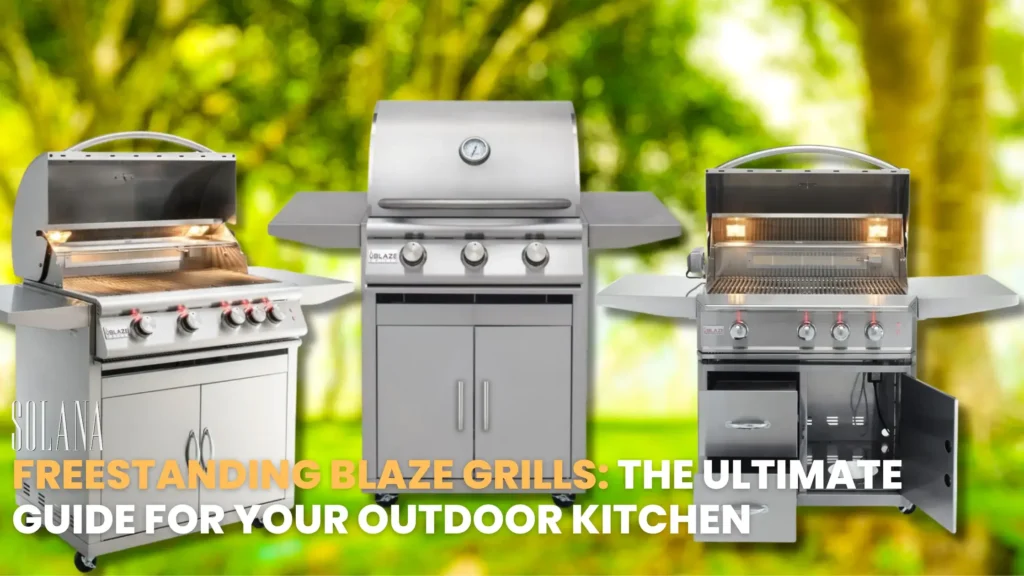
The right grill can elevate your outdoor cooking experience, transforming every meal into a masterpiece. Freestanding Blaze Grills are a top choice for grill enthusiasts who want flexibility, convenience, and high performance in their outdoor kitchens. Whether you are a seasoned griller or a weekend BBQ warrior, selecting the right freestanding grill and accessories will enhance your grilling experience, improve safety, and make outdoor cooking more enjoyable. Why Choose Freestanding Blaze Grills? Choosing the right grill for your backyard grilling setup is crucial, and Freestanding Blaze Grills offer numerous advantages. Unlike built-in grills, freestanding models provide the flexibility to move the grill when needed, making them perfect for those who want a dynamic outdoor cooking solution. Here’s why Blaze Grills stand out: Portability: Unlike fixed built-in grills, freestanding models allow you to rearrange your outdoor kitchen setup effortlessly. Durability: Constructed with stainless steel grills, Blaze Grills are designed to withstand outdoor elements and offer long-term reliability. Premium BBQ Performance: Blaze Grills deliver consistent, high-quality grilling with features like precise temperature control, multiple burners, and heat distribution systems. Versatile Cooking: Whether searing steaks or slow-roasting ribs, Blaze Grills offer the flexibility needed for diverse culinary experiences. Effortless Assembly: Most freestanding models require minimal setup, making them an excellent choice for beginners and experts alike. Setting Up Your Outdoor Kitchen with Freestanding Blaze Grills Designing a functional and stylish outdoor kitchen starts with choosing the right grill. Freestanding Blaze Grills can seamlessly integrate into various backyard layouts. Here are some tips to optimize your grilling area: Choose a strategic location: Place the grill in an open space with proper ventilation to avoid smoke buildup. Incorporate storage solutions: Adding cabinets and shelving around your grill helps keep cooking utensils and seasonings within reach. Consider safety measures: Keep a fire extinguisher nearby and ensure the grill is on a non-flammable surface. Accessorize for convenience: Enhance your experience with side tables, warming racks, and grill lights. Invest in weather protection: Outdoor kitchens are exposed to the elements, so adding an overhead cover or grill cover will extend the lifespan of your grill. Freestanding vs. Built-In Grills: A Comparative Analysis If you’re debating between freestanding grills and built-in grills, understanding the key differences can help you make an informed decision. Feature Freestanding Blaze Grills Built-In Grills Portability Can be moved and repositioned Fixed in one location Installation Requires minimal setup Needs professional installation Cost Generally more affordable Higher upfront investment Maintenance Easier to clean and service More effort required for maintenance Space Requirement Can fit in different layouts Requires dedicated counter space Resale Value Can be moved to a new home Increases property value For those who frequently entertain guests and need flexibility, freestanding grills are the better choice. However, if you have a dedicated outdoor kitchen with a permanent layout, built-in grills could be more suitable. High-Performance Grilling with Freestanding Blaze Grills One of the standout features of Freestanding Blaze Grills is their high-performance grilling technology. These grills are designed for both professional chefs and casual backyard grillers. Key features include: Stainless Steel Construction: Crafted from stainless steel, this grill offers exceptional durability while resisting rust and corrosion for long-lasting performance. Infrared Burner Technology: Provides superior heat retention and distribution. Heat Zone Separators: Allow precise temperature control for different cooking zones. Illuminated Control Knobs: Enhance visibility for nighttime grilling. Flame Stabilizing Grids: Reduce flare-ups and promote even heat distribution. Easy Ignition Systems: Reliable and hassle-free startup every time. With these advanced features, Blaze Grills provide the high-performance grilling experience that every BBQ enthusiast desires. Enhancing the Grilling Experience with Accessories To get the most out of your Freestanding Blaze Grill, investing in the right accessories is essential. These additions not only improve convenience but also ensure safety and efficiency while grilling. Grill Covers: Protects your grill from weather conditions and extends its lifespan. Rotisserie Kits: Enables slow and even cooking for poultry and roasts. Side Burners: Ideal for cooking side dishes while grilling your main course. Smoker Boxes: Adds rich smoky flavors to meats and vegetables. Drip Trays: Helps in easy cleanup and prevents grease flare-ups. Grill Tool Sets: Ensures you have the necessary utensils for precision cooking. Bluetooth Meat Thermometers: Provides real-time temperature monitoring for perfect grilling. Choosing the right accessories transforms your Freestanding Blaze Grill into a fully functional outdoor cooking solution. Creating the Perfect Backyard Grilling Setup A well-planned backyard grilling setup ensures that you maximize both space and functionality. Here are some essential elements to consider: Seating & Dining Area: Make sure there’s comfortable seating for guests to enjoy the meal fresh off the grill. Lighting & Ambiance: Install outdoor lighting to create a cozy evening atmosphere. Shade & Shelter: Adding a pergola or umbrella provides protection from sun and rain. Storage & Organization: Keep all grilling tools and accessories within easy reach. Outdoor Refrigeration: A small fridge for drinks and condiments enhances convenience. Entertainment Setup: Consider adding a Bluetooth speaker or outdoor TV for the ultimate BBQ experience. Combining these elements with your Freestanding Blaze Grill will create an inviting space for family and friends to gather and enjoy delicious meals. Maintaining Your Freestanding Blaze Grill Proper maintenance ensures that your grill remains in top condition for years to come. Follow these essential maintenance tips: Regular Cleaning: Wipe down surfaces and remove grease buildup after each use. Deep Cleaning: Perform a deep clean every few months, removing grates and burners for thorough scrubbing. Check Gas Lines: Inspect for leaks or blockages to ensure safe operation. Protect Your Grill: Use a durable grill cover to shield it from the elements. Season the Grates: Apply a thin coat of oil to prevent rust and improve food flavor. Inspect Ignition Systems: Ensure your ignition system works properly for hassle-free grilling. Store Fuel Safely: Keep propane tanks in a well-ventilated area away from direct sunlight. By taking these simple steps, your Freestanding Blaze Grill will continue delivering premium BBQ results season after season. Conclusion Freestanding Blaze Grills are an excellent
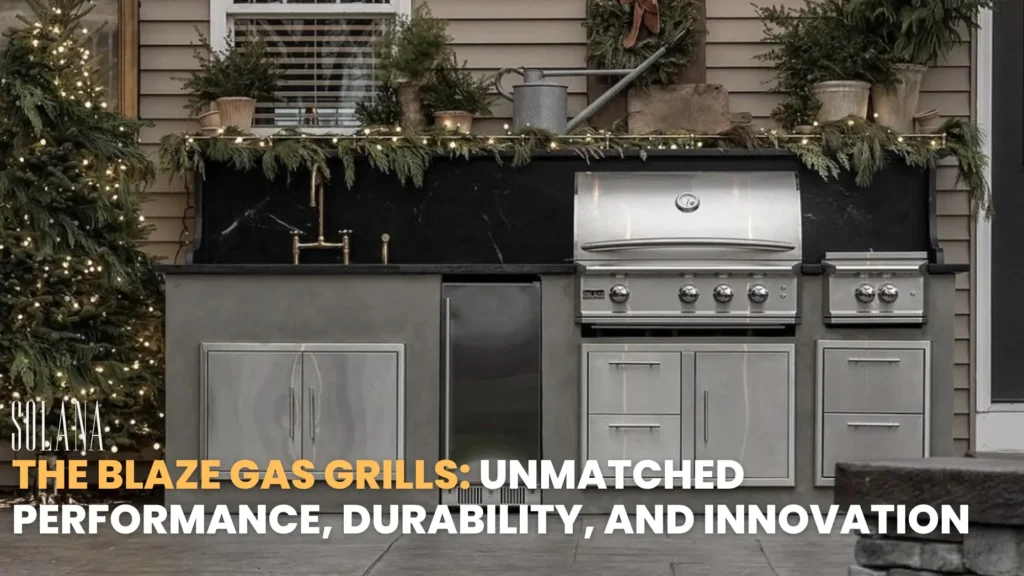
Blaze Gas Grills have revolutionized the world of outdoor cooking, offering a perfect blend of performance, durability, and innovation. If you’re a weekend griller or a seasoned pitmaster, having the right grill can elevate your cooking experience. Designed with high-quality materials, advanced grilling technology, and user-friendly features, Blaze Gas Grills provide unmatched efficiency and reliability. In this guide, we’ll explore what makes these grills stand out, along with the accessories that enhance safety, convenience, and the overall grilling experience. The Performance of Blaze Gas Grills One of the standout features of Blaze Gas Grills is their high-performance grilling capabilities. Engineered to deliver consistent heat distribution and precision control, these grills allow you to achieve restaurant-quality results right in your backyard. High-Performance Grilling Blaze Gas Grills are built for serious grillers who demand precision and power. With high BTU burners and advanced temperature controls, they ensure even cooking and a perfect sear every time. The high-performance grilling system minimizes hot and cold spots, allowing you to cook food evenly. Stainless Steel Grills for Maximum Heat Retention The construction of Blaze Gas Grills features 304 stainless steel, known for its superior durability and resistance to rust and corrosion. Stainless steel grills not only offer longevity but also retain heat efficiently, ensuring optimal cooking conditions. The double-lined grill hoods help trap heat and improve fuel efficiency. Infrared Burners for Intense Heat For those who love the perfect steakhouse sear, Blaze Gas Grills come with optional infrared burners. These burners use infrared technology to generate extremely high temperatures quickly, locking in juices and creating a flavorful crust on meats. Infrared burners are ideal for cooking steaks, chops, and other meats that require high heat. Durability That Stands the Test of Time Durability is a defining characteristic of Blaze Gas Grills. Crafted with premium materials and robust construction, these grills are designed to withstand the elements and provide long-term performance. Premium Gas Grills Built to Last Blaze Gas Grills are made with commercial-grade materials, ensuring they stand up to years of grilling. The 304 stainless steel body resists wear and tear, even in harsh outdoor environments. With a solid frame and reinforced grill grates, these grills maintain structural integrity over time. Heat Zone Separators for Enhanced Longevity A unique feature of Blaze Gas Grills is the heat zone separators. These allow for different temperature zones within the same grill, preventing excessive wear and tear on certain parts of the grill. This feature also enhances fuel efficiency, allowing for better heat control while cooking multiple items simultaneously. Innovation in Grilling Technology Blaze Gas Grills integrate cutting-edge grilling technology, making outdoor cooking more convenient and efficient. Advanced Ignition Systems A dependable ignition system is key to a seamless and stress-free grilling experience. Blaze Gas Grills feature push-and-turn flame-thrower ignition systems, which provide quick and reliable startup every time. Some models even include backup ignition systems to ensure you’re never left without a flame. Heat Zone Separators for Precision Cooking Blaze Gas Grills incorporate heat zone separators, which allow for different temperature zones within the cooking area. This feature is perfect for grilling a variety of foods at once—searing steaks on high heat while slow-cooking vegetables at a lower temperature. LED Illuminated Control Knobs For those who love to grill at night, Blaze Gas Grills include LED-illuminated control knobs. This feature not only enhances safety but also adds a sleek, modern look to your outdoor kitchen. Enhancing the Grilling Experience with Accessories To make the most of your Blaze Gas Grill, it’s important to invest in high-quality accessories that enhance safety, convenience, and cooking versatility. Must-Have Grilling Accessories Grill Covers: Protect your Blaze Gas Grill from the elements with a durable, weather-resistant cover. Rotisserie Kits: Add versatility to your grilling by slow-roasting whole chickens, roasts, and more. Grill Lights: Ensure visibility during nighttime grilling sessions with high-quality LED grill lights. Smoker Boxes: Infuse your food with smoky flavor by adding wood chips to a Blaze smoker box. Griddle Plates: Expand your cooking options by using a griddle plate for pancakes, eggs, or stir-fry. Safety Accessories for a Secure Grilling Experience Heat-Resistant Gloves: Protect your hands from high temperatures while handling hot grill components. Grill Mats: Keep your patio or deck safe from grease stains and flare-ups. Fire Extinguishers: Always have a fire extinguisher nearby for added safety during grilling. Maintenance Tips for Long-Lasting Performance Proper maintenance ensures your Blaze Gas Grill remains in peak condition for years to come. Follow these essential tips to keep your grill performing at its best: Clean the Grill Grates Regularly: After each use, brush the grates with a grill brush to remove residue and prevent buildup. Empty the Grease Tray: Regularly empty and clean the grease tray to avoid flare-ups and maintain cleanliness. Inspect the Burners: Check the burners for any clogs or debris that may affect performance and clean them as needed. Check for Gas Leaks: Periodically inspect the gas connections and hoses for leaks to ensure safe operation. Cover Your Grill: Use a weather-resistant grill cover to protect it from rain, dust, and harsh outdoor conditions. Deep Clean Periodically: At least once a season, give your grill a deep clean by removing and scrubbing internal components. Check the Ignition System: Ensure that the ignition system functions correctly and replace any faulty components promptly. Monitor the Flame Output: If your grill’s flame weakens or burns unevenly, clean the burners and ensure the gas supply is consistent. Store Propane Safely: If you use propane, always store your tanks in a well-ventilated, upright position, away from heat sources. Choosing the Right Blaze Gas Grill for Your Needs Blaze offers a variety of gas grill models to suit different cooking styles and outdoor kitchen setups. When selecting a Blaze Gas Grill, consider the following factors: Size and Cooking Space: Choose a grill with enough surface area to accommodate your grilling needs, whether you’re cooking for a small family or hosting large gatherings. Number of Burners: More burners provide greater flexibility for multi-zone cooking
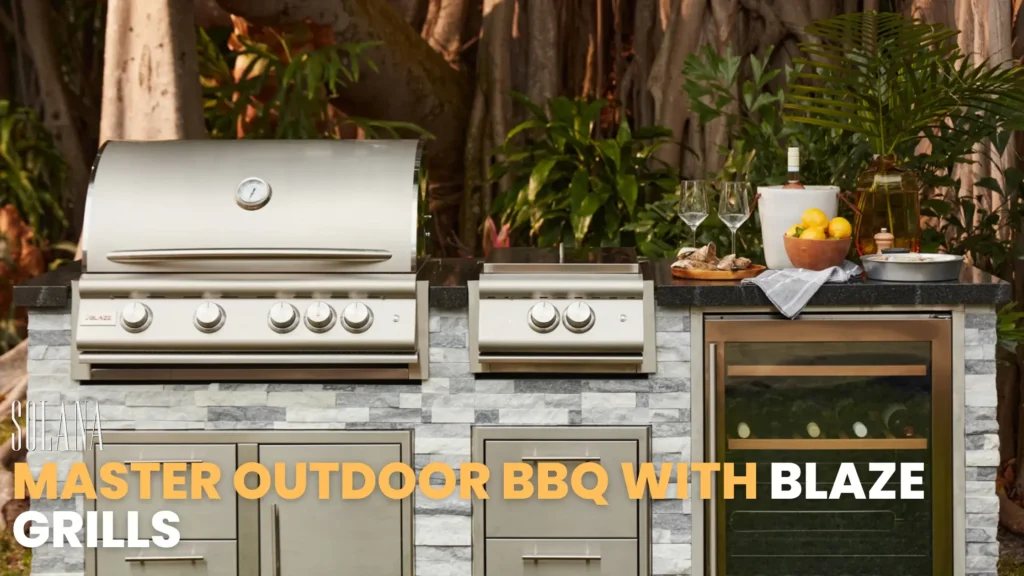
If you’ve ever dreamed of elevating your outdoor cooking game with top-notch equipment, then Blaze Grills is your answer. Known for their premium quality and superior performance, Blaze Grills have become a favorite among grilling enthusiasts and professionals alike. In this comprehensive guide, we’ll explore everything you need to know about Blaze Grills, from their unique features to maintenance tips and delectable recipes. Let’s dive into the world of Blaze Grills and discover why they’re a cut above the rest. Understanding Blaze Grills When it comes to outdoor cooking, Blaze Grills stand out for their excellent craftsmanship, innovative features, and variety of models to suit every need. Whether you’re a seasoned griller or just starting, Blaze Grills has something for everyone. Premium Craftsmanship and Design Blaze Grills are designed with precision and premium materials, ensuring durability and long-lasting performance. Made from commercial-grade stainless steel, these grills are built to withstand the rigors of outdoor environments while providing consistent heat distribution and cooking efficiency. The sleek design not only elevates the look of your outdoor kitchen but also makes cleaning and maintenance a breeze just another reason why people love The Blaze Gas Grills: Unmatched Performance, Durability, and Innovation. Variety of Models Blaze Grills offer a range of models, each catering to different types of outdoor cooking enthusiasts. From compact portable options to expansive built-in models, there’s a Blaze Grill for every setup and occasion. Blaze Prelude LBM: A great entry-level option, offering reliable performance and essential grilling features. Blaze LTE: Perfect for those looking for enhanced features like interior lighting, a rotisserie kit, and superior heat zone separators. Blaze Professional LUX: The top-of-the-line model designed for professional-level grilling, featuring cast stainless steel burners, advanced heat zone separators, and a double-lined grill hood for efficient heat retention. Choosing the Right Blaze Grill for You Choosing the right Blaze Grill depends on several factors, including your cooking habits, space availability, and preference between built-in and freestanding models Built-in vs. Freestanding Blaze Grills Blaze Grills offer both built-in and freestanding models, each with its own set of advantages: Built-in Blaze Grills: Ideal for outdoor kitchens, built-in models provide a seamless, professional look and are perfect for those who have a dedicated space for grilling. They integrate beautifully with outdoor countertops and cabinets, offering a custom feel and plenty of prep space. Freestanding Blaze Grills: These models offer greater flexibility as they can be moved and repositioned according to your needs. Equipped with sturdy carts and additional storage, freestanding grills are perfect for those who prefer versatility and mobility. For more help in making your decision, read our guide on Built-In vs. Freestanding Blaze Grills. Selecting the Right Model Choosing the perfect Blaze Grill depends on your cooking habits, the number of people you typically cook for, and the available space in your outdoor kitchen. Here are some key factors to consider: 1. Cooking Style & Frequency Frequent Grillers & Entertainers: If you often host large gatherings, opt for a larger model with multiple burners for enhanced cooking capacity. Features like a rotisserie kit and side burners will provide additional cooking versatility. Casual or Occasional Grillers: For smaller families or those who grill occasionally, a compact model with fewer burners may be sufficient. These models require less fuel and are easier to maintain. 2. Available Space & Layout Outdoor Kitchen Integration: If you have a spacious outdoor kitchen, consider a full-sized freestanding grill with built-in storage and prep areas. Limited Space Solutions: For smaller patios or balconies, a compact freestanding Blaze Grill provides high performance without taking up too much room. Portability Needs: If you prefer a flexible setup, choose a model with heavy-duty wheels for easy relocation. 3. Key Features to Look For Number of Burners: More burners allow better heat control and the ability to cook multiple dishes at once. Heat Zone Separators: Enables precise temperature management for different cooking styles. Infrared Burners: Ideal for searing meats at high temperatures while retaining moisture. Built-in Lighting: Illuminated control knobs and interior lighting improve nighttime visibility. Storage & Side Shelves: Additional storage space for utensils, seasonings, and accessories enhances convenience. 4. Fuel Type Consideration Natural Gas vs. Propane: Decide between a natural gas model for continuous fuel supply or a propane version for portability and ease of refueling. 5. Budget & Long-Term Investment Investing in a high-quality Blaze Grill ensures longevity and superior performance. While larger models come with a higher price tag, they offer better features and durability for long-term value. By assessing your grilling habits, available space, and desired features, you can confidently select the perfect Blaze Grill for your outdoor kitchen. Tips for Effective Blaze Grill Maintenance Maintaining your Blaze Grill is key to ensuring its longevity and optimal performance. Here are some essential tips on Blaze Grill maintenance: Regular Cleaning Maintaining a clean grill is essential for optimal performance and food safety. After each use, make sure to: Clean the grates: Use a grill brush to remove any food residue and grease from the grates. Clear out the grease tray: frequently to reduce buildup and minimize the risk of flare-ups. Wipe down surfaces: Use a damp cloth to wipe down the exterior and interior surfaces of your grill. Here are some essential tips on Blaze Grill maintenance: Deep Cleaning Periodically, give your Blaze Grill a thorough clean: Remove and clean the burners: Take out the burners and clean them with soapy water. Clean the heat zone separators: These help in even heat distribution and should be kept clean for efficient performance. Check the gas lines: Inspect gas lines for leaks or blockages and ensure everything is securely connected. For a more detailed maintenance guide, visit our article on Blaze Grill Maintenance. Exploring Blaze Grills Recipes One of the joys of owning a Blaze Grill is the variety of recipes you can master. From simple weeknight dinners to elaborate weekend feasts, Blaze Grills can handle it all. Classic BBQ Recipes Blaze Grills excel in delivering perfect BBQ dishes every time.
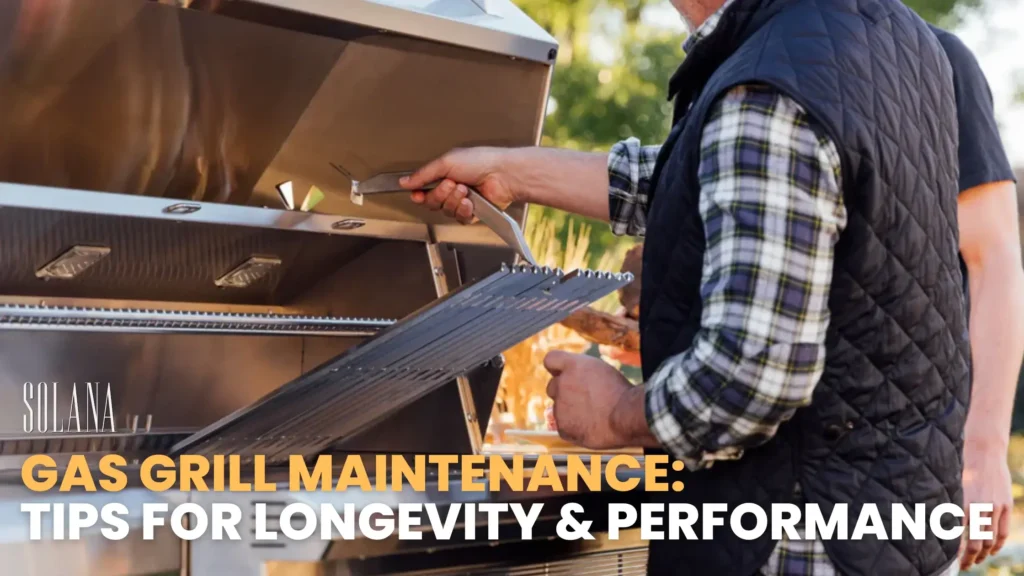
Small Gas grill maintenance is key to making sure your grilling experience is always top-notch, enhancing both the safety and convenience of your outdoor cooking adventures. A well-maintained grill not only performs better but also lasts longer, providing you with years of delicious meals. This comprehensive guide will walk you through essential maintenance and care tips to ensure your gas grill remains in excellent condition. The Importance of Regular Gas Grill Maintenance Benefits of Consistent Maintenance Regular gas grill maintenance is crucial for several reasons that extend beyond mere cleanliness. Here’s a closer look at why maintaining your grill is so essential: Enhanced Performance: Consistent cleaning and upkeep ensure that your grill operates at its best, providing even heating and superior cooking results. Improved Safety: Routine maintenance helps prevent dangerous flare-ups, gas leaks, and fire hazards. Extended Lifespan: Proper care and attention can significantly prolong the life of your grill, saving you money in the long run. Better Flavor: Regular cleaning prevents food residue buildup, which can affect the taste of your meals. Cost Efficiency: Maintaining a grill is cheaper than repairing or replacing neglected equipment. Investing time in proper gas grill maintenance ensures that you’ll enjoy a safer, more efficient, and longer-lasting grill. Cleaning Tips for Small Grills Keeping your grill clean is a cornerstone of gas grill maintenance. Here, we’ll provide some detailed cleaning tips for small grills to ensure even the most compact models remain in top condition: Step-by-Step Cleaning Guide: Preheat and Scrape: Turn on the grill and let it preheat for 15 minutes. This loosens food particles. Use a grill brush to scrape the grates clean while they’re still warm. Remove Grates and Clean Thoroughly: Once cooled, remove the grates and soak them in warm, soapy water. Scrub with a stiff brush to remove any remaining residue. Clean the Burner Protectors: Carefully remove the burner protectors and scrub off grease and debris. Rinse and dry them thoroughly before reassembling. Wipe Down the Interior: Use a grill cleaner to spray the interior surfaces. Wipe everything down with a damp cloth to remove soot and grease. Empty the Drip Pan: Regularly empty and clean the drip pan to prevent flare-ups. Special Considerations for Small Grills: Compact Brushes and Tools: Use smaller-sized brushes and tools to reach tight spaces. Frequent Cleaning: Because small grills accumulate grease faster, clean them more frequently. Following these cleaning tips will help maintain your small grill’s performance and longevity. Essential Accessories for Effective Gas Grill Maintenance To perform effective maintenance, having the right tools is essential. Here are some key accessories you’ll need, as highlighted in this grill care guide: 1. Grill Brushes A grill brush with sturdy bristles is indispensable for cleaning grates and removing food debris. Opt for a brush with a long handle to keep your hands safe from the heat. 2. Grill Covers A high-quality grill cover protects your grill from the elements, preventing rust and wear. Look for weather-resistant materials and ensure the cover fits snugly. 3. Cleaning Solutions Grill-specific cleaning solutions help break down grease and grime more effectively than general cleaners. Use these products on both the interior and exterior surfaces. 4. Drip Pans and Foil Liners Disposable drip pans and foil liners catch grease and make clean-up a breeze, reducing the risk of flare-ups and keeping your grill cleaner for longer. 5. Heat-resistant Gloves Protective gloves allow you to handle hot grates and accessories safely, preventing burns and accidents during maintenance. Equipped with these accessories, you’ll find maintaining your gas grill significantly easier and more efficient. Seasonal Maintenance Tips Different seasons bring varying challenges for grill maintenance. Here’s a quick guide to help you keep your gas grill in great shape year-round: Spring Deep Clean: Start the grilling season with a thorough cleaning. Remove all parts and scrub away any accumulated grime. Inspect for Damage: Check for any rust, cracks, or signs of wear that may have occurred during winter. Summer Regular Cleaning: During peak grilling season, clean your grill regularly to prevent grease buildup. Cover When Not in Use: Use a grill cover between uses to protect from summer storms and debris. Fall Pre-Winter Prep: Before storing your grill for winter, give it another deep clean. Disconnect Propane: Safety first—disconnect the propane tank and store it in a cool, dry place. Winter Storage: If you live in a cold climate, store your grill in a garage or shed to protect it from snow and ice. Cover Up: If outdoor storage is your only option, invest in a heavy-duty cover designed for winter weather. By following these seasonal maintenance tips, you’ll ensure that your grill remains ready to fire up whenever you need it. Troubleshooting Common Gas Grill Problems Even with diligent maintenance, gas grills can encounter issues. Here’s how to troubleshoot some common problems: Problem: Uneven Heating Solution: Uneven heating is often caused by clogged burners. Remove the burners and clean them with a brush and soapy water. Ensure they’re free from obstructions before reassembling. Problem: Grill Won’t Light Solution: Check the ignition system first—replace batteries if necessary. Make sure the gas supply is securely connected and switched on. Check the burners and gas lines for any obstructions to ensure proper flow. Problem: Excessive Smoke Solution: Excess smoke usually means there’s too much grease buildup. Clean the grates, burner protectors, and the interior of the grill. Also, adjust the fuel mixture if possible. Problem: Yellow or Orange Flame Solution: A yellow or orange flame indicates poor air-gas mixture. Clean the burner ports and ensure the air shutters are open. Refer to your grill’s manual for adjustments. By addressing these issues promptly, you can avoid more serious damage and keep your grilling sessions smooth and enjoyable. Long-term Care for Gas Grills For long-term success, it’s essential to adopt some advanced maintenance strategies. Here’s how to keep your gas grill in optimal condition over the years: 1. Schedule Annual Deep Cleans Once a year, disassemble your grill completely and clean each component thoroughly. Inspect all
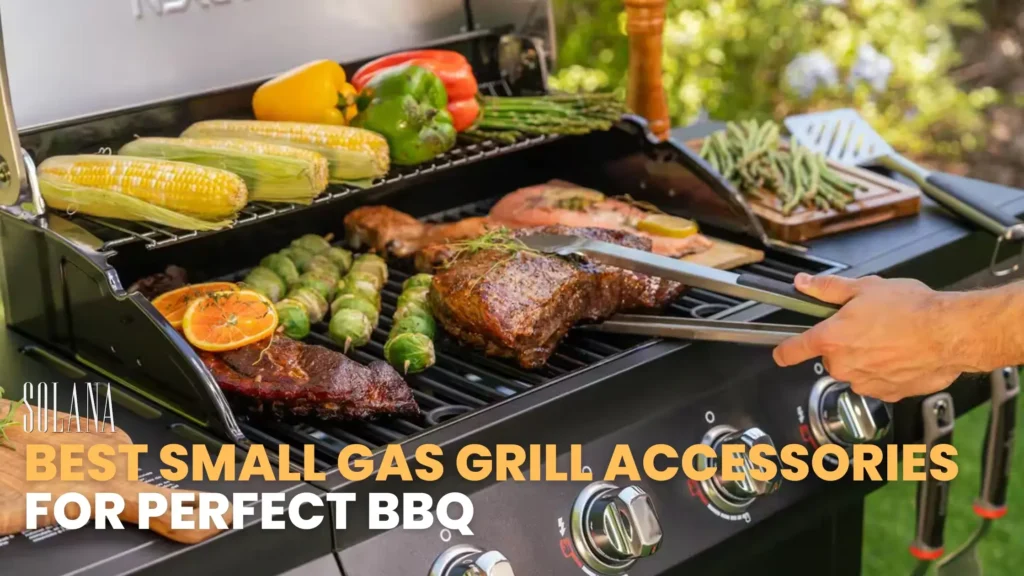
When it comes to small gas grills, the right grill accessories can make all the difference, enhancing your grilling experience, improving safety, and ensuring convenience. Having the perfect set of tools and gadgets not only makes grilling more enjoyable but also elevates the taste and quality of your food. In this comprehensive guide, we’ll delve into the best accessories for small gas grills, ensuring you have everything you need for an exceptional grilling journey. Must-Have BBQ Tools for Every Grill To start with, let’s talk about the must-have BBQ tools that every grill enthusiast needs. These essential accessories enhance grilling efficiency and safety, making them indispensable for both beginners and seasoned grillers. 1. Grill Tongs A sturdy pair of grill tongs is fundamental. Look for tongs with a long handle to keep your hands safe from the heat, and ensure they offer a good grip for flipping and moving food around the grill. 2. Spatula A high-quality spatula is crucial for flipping burgers, fish, and delicate veggies. Opt for a spatula with a beveled edge to easily slide under food and a long handle for safety. 3. Grill Brush Maintaining a clean grill is crucial for optimal performance and food safety. A durable grill brush with stiff bristles helps scrub off burnt-on food and grease, preserving the lifespan of your grill grates. 4. Meat Thermometer Achieve perfect doneness with a digital meat thermometer. This tool ensures your food is cooked to the right temperature, enhancing both flavor and safety by preventing undercooked meat. 5. Basting Brush For perfectly marinated and glazed food, a good basting brush is a must. Look for silicone bristles that can withstand high temperatures and are easy to clean. 6. Grill Basket A grill basket is perfect for cooking smaller items like vegetables or shrimp that might fall through the grates. It keeps everything contained and makes for easy flipping and serving. By equipping yourself with these must-have BBQ tools, you’ll streamline your grilling process and elevate your culinary creations. Best Grill Gadgets to Elevate Your Grilling Now, let’s look at some of the best grill gadgets that bring your grilling game to the next level. These innovative tools add fun and functionality to your outdoor cooking adventures. 1. Wireless Meat Thermometer Monitor your food’s temperature without being tethered to the grill. A wireless meat thermometer allows you to keep an eye on your cooking progress from a distance, ensuring perfect results every time. 2. Rotisserie Kit Add a professional touch to your grilling with a rotisserie kit. This gadget ensures even cooking for larger cuts of meat like whole chickens or roasts, delivering incredibly juicy and flavorful results. 3. Grill Light Grilling after dark? A grill light is a handy gadget that attaches to your grill handle and illuminates your cooking area, ensuring you can see what you’re doing even in low light conditions. 4. Smoking Box Introduce a smoky flavor to your gas-grilled dishes with a smoking box. Fill it with wood chips and place it on your grill grates to infuse your food with that delectable, smoky taste. 5. Grill Mats Grill mats are perfect for grilling delicate items that might stick or fall apart, like fish or thin-cut vegetables. They offer a non-stick surface, ensuring hassle-free cooking and effortless cleanup. 6. Grill Thermometer A built-in grill thermometer helps you monitor the ambient temperature inside the grill. This gadget is crucial for maintaining consistent heat, especially during long cooking sessions. With these best grill gadgets in your arsenal, you’ll enjoy enhanced functionality and fun, making each grilling session a true delight. The Importance of Safety Accessories for Small Gas Grills Safety is paramount when it comes to grilling, especially with small gas grills. Investing in the right safety accessories can prevent accidents and ensure a worry-free grilling experience. 1. Heat-Resistant Gloves Shield your hands from intense heat with durable, heat-resistant gloves. These gloves provide a secure grip and protect against burns when handling hot grates or accessories. 2. Fire Extinguisher Always have a fire extinguisher nearby when grilling. A small, portable extinguisher designed for grease fires can be a lifesaver in case of unexpected flare-ups. 3. Drip Pans Drip pans catch grease and prevent flare-ups. They also make cleanup easier and reduce smoke, enhancing overall safety and convenience. 4. Grill Mat Place a grill mat under your grill to protect your deck or patio from grease spills and heat damage. Designed to withstand high temperatures, these mats are also effortless to clean. 5. Gas Leak Detector Ensure your small gas grill is operating safely with a gas leak detector. This tool helps you identify any potential leaks in your propane line, preventing dangerous situations before they happen. By incorporating these safety accessories, you’ll create a safer grilling environment, allowing you to focus on enjoying the food and company. Convenience – Enhancing Accessories for Small Gas Grills Convenience-enhancing accessories make using small gas grills more enjoyable by adding ease and efficiency to your grilling routine. 1. Tool Rack Keep your grilling tools organized and within reach with a tool rack. This accessory attaches to your grill and provides hooks for hanging tongs, spatulas, and basting brushes. 2. Side Tables Side tables expand your prep space, making it easier to handle food and utensils. Many small gas grills come with foldable side tables or you can add detachable ones. 3. Grill Cover A grill cover protects your grill from the elements when not in use. It prevents rust and keeps your grill clean, extending its lifespan. Opt for a well-fitted cover crafted from sturdy, weatherproof materials to ensure lasting protection. 4. Storage Cabinets For those with a bit more room, storage cabinets built into or under your grill can hold propane tanks, tools, and accessories, keeping everything tidy and easily accessible. 5. Hose Connectors Flexible propane hose connectors make attaching your propane tank to the grill easier. These connectors allow for more maneuverability and are particularly useful for moving your grill around your outdoor











